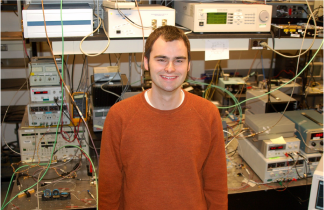 (Left: August Cover of Nature Materials showing Liu et al s work on gas sensing using plasmonic response from a triangular nanoantenna. The work in the Nature article was expanded from that presented in CLEO 2011, postdeadline session)
(Left: August Cover of Nature Materials showing Liu et al s work on gas sensing using plasmonic response from a triangular nanoantenna. The work in the Nature article was expanded from that presented in CLEO 2011, postdeadline session)
This year may not be a flush for the market but it is looking good for plasmonics. Expansion of the the work shown in CLEO 2011, Postdeadline paper "Nanoantenna-enhanced gas sensing in a single tailored nanofocus," from Na Liu et al. just took the August cover of Nature Materials (see the figure above). Additionally, plasmonics has had a solid recent run of the main-stream physics circuit after the publication of two Physics Today articles earlier this year in February and July.
The July issue of Physics Today features an article by Lukas Novotny from University of Rochester in which he reviews near-field optics, the broader category where plasmonics resides. Earlier in the year, Mark Stockman of Georgia State University wrote a very accessible and informative article on nanoplasmonics that took the cover of the February issue of Physics Today. The cover shows a 13th century stained glass window of Sainte Chappelle in Paris whose yellow and red brilliance are assumed to come from nanoplasmonic resonances of silver and gold nanoparticles in the glass. The optical effect of how the red changes over the length of the window is said to have purposely been designed to mimic the flowing blood of Christ.

(Above: Sketch of Edward Synge's proposed near-field microscope. The red dot denotes the gold nanoparticle. Picture from L. Novotny, Phys. Today, 64, 47 (2011))
Novotny's July article also offers a romantic insight into the history of near-field optics and plasmonics. Novotny, recounts how in 1928, Edward Synge wrote a "prophetic letter" to Einstein proposing a near-field microscope (see Figure above) to optically image a biological sample below the diffraction limit. Synge's proposed microscope, which could not be realized until 1982 (by Dieter Phol's group at IBM of Switzerland), looks eerily familiar to current techniques used for the development of plasmonic devices and sensing- the use of metallic nanoparticles to generate surface plasmons in order to enhance a probing optical field. The two Physics Today articles are must-reads for those who need a crash-course on plasmonics.
A plasmon is created when the electrons on a metal surface are periodically displaced with respect to the lattice ions by an external, driving, optical field, creating an "electron oscillator." The frequency of the surface plasmon depends not on the driving field, but instead upon the restoring force and effective mass of the electrons in the metal. Changing the size and geometry of the metal structure will alter the restoring force and thereby the plasmon frequency. Using metallic nanostructures of the right size (smaller than the skin depth of the metal but bigger than the distance an electron moves during on optical cycle, 2-20 nm) the electric field due to the plasmon becomes highly localized in the immediate vicinity of the outer surface of the nanostructure (see the Figure below). By coupling the surface plasmon to propagating optical radiation, nanoscale information from the plasmon can be encoded micron-sized optical waves as it is in near-field microscopy. The highly localized field can also be used for a number of sensing techniques like SERS by which the interaction of a probe beam with a molecule is significantly enhanced due to the presence of nearby nanostructures. The cover article from Nature Materials uses a standard plasmonics approach by using redshifted plasmon response itself from a gold triangle structure for ultra-sensitive detection of hydrogen.

(Above: Diagram of plasmon dynamics on a 10 nm silver nanosphere. Eo represents the external light field, the black arrows represent the electric field from displaced electrons, the plasmon field, and the red arrows show the field inside the sphere. Picture from M. Stockman, Phys. Today, 64, 39 (2011) )
The exciting field of plasmonics has applications and positive repercussions in other fields as well. Tumor cells have been found to readily take up nanoparticles. By illuminating tissues with non-lethal IR light, the heat generated from enhanced local-fields of the high-Q nanostructures selectively kills cancer cells. Plasmon-enhanced solar energy conversion entails using metallic structures to better localize light for solar concentration. The opening tutorial, "Solar Energy Applications of Plasmonics," by Professor Harry Atwater of Caltech in CLEO:QELS session "Frontier Applications of Plasmoincs" during CLEO 2011, addressed this burgeoning new field.
There is no doubt that CLEO 2012 will host a number of technical and invited talks, both fundamental and applied, on the subject of plasmonics. After reading the Physics Today articles, I think I will have to add a lecture or two on plasmonics in my junior-level E&M class this fall. I will definitely have to attend some plasmonic talks next CLEO to learn more about this extremely interesting work that saddles fundamental physics and cutting-edge applications.
